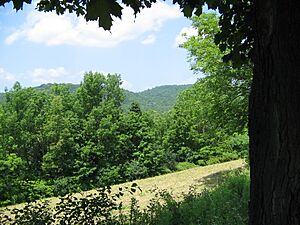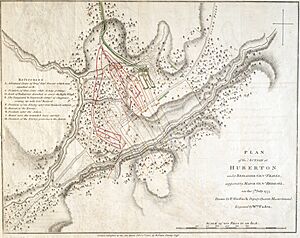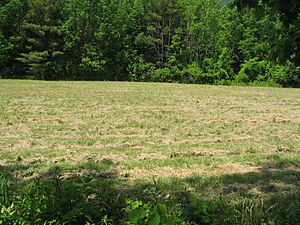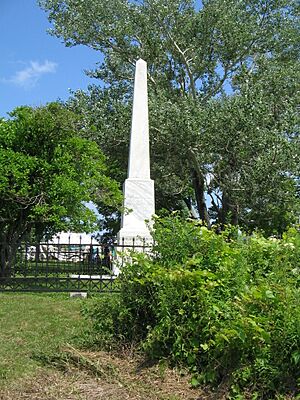Battle of Hubbardton facts for kids
Quick facts for kids Battle of Hubbardton |
|||||||
|---|---|---|---|---|---|---|---|
| Part of the American Revolutionary War | |||||||
Detail of a 1780 map showing the area around Fort Ticonderoga; "Huberton" can be seen southeast of the fort. |
|||||||
|
|||||||
| Belligerents | |||||||
|
|
Iroquois |
||||||
| Commanders and leaders | |||||||
|
|
Freiherr Riedesel | ||||||
| Strength | |||||||
| 2,000 men | 1,030 men | ||||||
| Casualties and losses | |||||||
| 41–150 killed 96–457 wounded 230 captured |
49–60 killed 141–168 wounded |
||||||
The Battle of Hubbardton was an important fight during the American Revolutionary War. It happened on July 7, 1777, in a place called Hubbardton, which is now in Vermont. At that time, Vermont was a new, independent area, but other states like New York and New Hampshire also claimed it.
This battle was part of a bigger plan by the British called the Saratoga campaign. The British wanted to control the Hudson River valley. The fight at Hubbardton happened when British soldiers, led by General Simon Fraser, chased after American soldiers. The Americans were retreating after leaving Fort Ticonderoga. This was the only battle of the Revolutionary War that took place in what is now Vermont.
The American army, led by General Arthur St. Clair, had to leave Fort Ticonderoga quickly. They saw that the British had placed cannons on a high hill overlooking their fort. This made the fort unsafe. So, on the night of July 5, the Americans began to retreat. Most of the army marched towards Castleton. A group called the rear guard, led by Seth Warner, stayed behind in Hubbardton to rest and gather any soldiers who had fallen behind.
General Fraser found out about the American retreat early on July 6. He immediately started chasing them. That night, Fraser's troops camped close to Hubbardton. German soldiers, led by General Friedrich Adolf Riedesel, were also coming to help Fraser. Early the next morning, Fraser's soldiers surprised some of the American rear guard. A fierce battle began. The Americans fought hard but were eventually forced to retreat when the German reinforcements arrived.
Even though the British won this battle, it cost them many soldiers. This meant they couldn't chase the main American army any further. Many American prisoners were sent back to Ticonderoga. The remaining American soldiers managed to rejoin their main army.
Contents
Why the Battle Happened
In 1777, General John Burgoyne led a large British army from Canada down Lake Champlain. His goal was to take control of the Hudson River valley. This would cut off New England from the other American colonies. On July 1, Burgoyne's army reached Fort Ticonderoga.
On July 5, the American soldiers defending Fort Ticonderoga made a worrying discovery. British cannons were now on a high hill called Mount Defiance. This hill looked right down into their fort. The American commander, General Arthur St. Clair, knew his fort was now in danger. He decided to evacuate the fort that very night. Most of his army marched quickly on a rough road towards Hubbardton. It was a very hot day, and the march was tough. Many soldiers walked about 30 miles (48 km) to Castleton before stopping to rest.
British Soldiers Chase the Americans
On July 6, the British General Simon Fraser found out that the Americans had left Ticonderoga. He quickly gathered his best soldiers, including grenadiers and light infantry, and about 100 Loyalists and Native American scouts. He immediately set off to chase the Americans. General Burgoyne also ordered German soldiers, led by Baron Friedrich Adolf Riedesel, to follow Fraser.
The American General St. Clair stopped at Hubbardton. He wanted his tired soldiers to rest. He also hoped his rear guard would catch up. When they didn't arrive quickly, he left Colonel Seth Warner and his Green Mountain Boys behind. Colonel Nathan Hale and his New Hampshire soldiers also stayed. Their job was to wait for the rest of the rear guard.
When the last of the rear guard arrived, Colonel Warner made a big decision. He decided they would spend the night in Hubbardton, even though St. Clair had told them to keep marching to Castleton. Warner had experience fighting in the back of an army. He set up their camps in a good defensive spot on Monument Hill. He also sent out patrols to watch the road from Ticonderoga.
Baron Riedesel and his German troops caught up with Fraser around 4 pm. Riedesel said his men were too tired to go further that day. Fraser agreed, but he told Riedesel he would start marching again at 3 am the next morning. Fraser then moved his troops a few miles closer to Hubbardton and camped for the night. Riedesel waited for more of his soldiers to arrive before making his own camp.
The Battle Begins
Fraser's soldiers woke up at 3 am, but it was still dark, so they moved slowly. Riedesel also left his camp at 3 am with a small group of soldiers. Fraser's men reached Hubbardton near dawn. They almost completely surprised some of Hale's American soldiers, who scattered in the first moments of the fight.
Just then, a message arrived for the Americans from General St. Clair. It said the British had reached Skenesboro. This was where the Americans had planned to regroup. St. Clair now ordered his troops to take a different, longer route to the Hudson River. He told them to follow him immediately to Rutland.
Colonel Francis's American soldiers were just forming a line to march out when the British appeared over the hill behind them. The Americans quickly formed a new line behind some cover. They fired a powerful volley of shots at the tired British soldiers. General Fraser quickly saw what was happening. He sent some of his soldiers to attack the American left side. He hoped his own left side would hold until Riedesel arrived.
Riedesel reached the top of another hill and saw that the Americans were pushing hard on Fraser's left side. He immediately sent his best soldiers, the grenadiers, to help Fraser's flank. He also sent his jägers (skilled German riflemen) to attack the center of the American line.
During the battle, General St. Clair heard the gunfire in the distance. He sent two officers, Henry Brockholst Livingston and Isaac Dunn, to get nearby militia (local soldiers) to help. But when they reached the militia camps, they found the soldiers running away from the sound of the battle. No one could convince them to turn back. Livingston and Dunn kept riding towards Hubbardton.
The Americans fell back to a strong position on Monument Hill. They fought off several strong British attacks. Colonel Francis was shot in the arm but kept fighting. He directed his troops to a weak spot he saw on Fraser's left side.
The battle changed after more than an hour of fighting. Riedesel's German grenadiers arrived. These well-trained soldiers marched into the fight singing hymns and playing music. This made them seem like there were more of them than there actually were. The American sides were pushed back, and they had to run across an open field to avoid being surrounded. Colonel Francis was killed by a volley of musket fire as his troops ran away and scattered into the countryside.
What Happened Next
The American soldiers who escaped from Hubbardton tried to reach Rutland to rejoin their main army. They were chased by Fraser's scouts and Native American allies. Without food or shelter, some of them took five days to reach the army. Livingston and Dunn met the retreating Americans on the road. They returned to Castleton with the news. St. Clair then marched his army towards Fort Edward, which they reached on July 12. Other American soldiers, including Colonel Hale and about 230 men, were captured. The British buried Colonel Francis with respect, alongside their own German dead.
Baron Riedesel and his German soldiers left for Skenesboro the next day. This left Fraser with about 600 tired men, many prisoners, and wounded soldiers, and not enough supplies. On July 9, he sent the 300 prisoners towards Ticonderoga. He then marched his exhausted troops towards Castleton and then Skenesboro.
Even though many Americans were captured, the main part of St. Clair's army escaped. This escape was very important. It helped the Americans win later battles, like the Battle of Bennington and the Battles of Saratoga. The Battle of Hubbardton was a tactical victory for the British because they defeated the American rear guard. But it was a strategic victory for the Americans. Their main army was able to keep fighting against Burgoyne's invasion.
Hubbardton Battlefield Historic Site
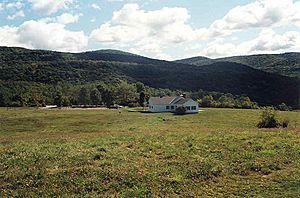
Hubbarton Battlefield Visitor Center
|
|
| Location | 5696 Monument Hill Road Hubbardton, Vermont |
|---|---|
| Type | Visitor center |
| Owner | State of Vermont |
In 1859, a monument was built on the battlefield. Since the 1930s, the state of Vermont has bought parts of the battlefield. Today, the Hubbardton Battlefield is a state historic site. It has been managed by Vermont's Division for Historic Preservation since 1937.
The battlefield was added to the National Register of Historic Places in 1971. Every year, people hold reenactments of the Revolutionary War here. The site has a visitor center with exhibits. These exhibits tell the story of the Battle of Hubbardton and its place in the Revolutionary War. There is also a trail with signs that explain important parts of the battle.


